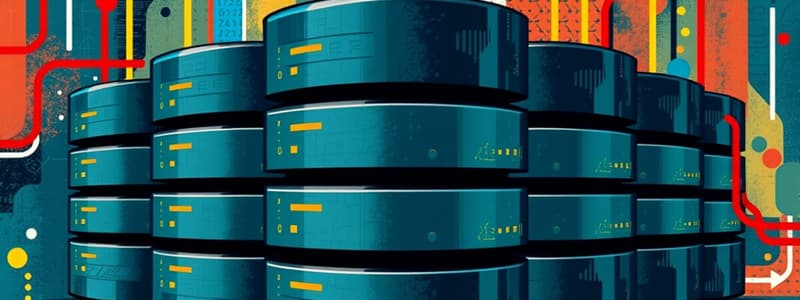Podcast
Questions and Answers
What should one understand before designing a database?
What should one understand before designing a database?
- Basic concepts and terminologies related to databases (correct)
- The graphical layout of database applications
- The economic implications of database design
- The history of information management systems
What is a Database Management System primarily used for?
What is a Database Management System primarily used for?
- To organize, store, and retrieve data from a computer (correct)
- To process transactions in real time
- To conduct online marketing campaigns
- To create user interfaces for applications
Which of the following is an advantage of using a Database Management System?
Which of the following is an advantage of using a Database Management System?
- High costs associated with software and maintenance
- Limitation in data sharing among users
- Centralized data management leading to improved accuracy (correct)
- Increased data redundancy and inconsistency
Which component is NOT typically part of a Database Environment?
Which component is NOT typically part of a Database Environment?
How does traditional file processing differ from the database approach?
How does traditional file processing differ from the database approach?
What encompasses the cycle of Information Management?
What encompasses the cycle of Information Management?
What is one disadvantage of using a Database Management System?
What is one disadvantage of using a Database Management System?
Why is understanding database functions important for individuals?
Why is understanding database functions important for individuals?
What is a database primarily described as?
What is a database primarily described as?
Which of the following activities most likely involves the use of a database?
Which of the following activities most likely involves the use of a database?
What significant change occurred with the emergence of computers in relation to databases?
What significant change occurred with the emergence of computers in relation to databases?
In modern terms, which of the following items can be stored in a database?
In modern terms, which of the following items can be stored in a database?
What is the definition of data in a modern context?
What is the definition of data in a modern context?
What is the purpose of processing data into information?
What is the purpose of processing data into information?
What historically prompted the need for databases?
What historically prompted the need for databases?
Which of the following statements about information is true?
Which of the following statements about information is true?
What distinguishes data from information?
What distinguishes data from information?
Which best describes metadata?
Which best describes metadata?
How can data be converted into information?
How can data be converted into information?
What is one characteristic of traditional file processing systems?
What is one characteristic of traditional file processing systems?
Which of the following is NOT a property typically found in metadata?
Which of the following is NOT a property typically found in metadata?
What does the term 'data about data' refer to?
What does the term 'data about data' refer to?
Why were computers primarily used for scientific calculations in the early days of data processing?
Why were computers primarily used for scientific calculations in the early days of data processing?
What is an example of traditional file processing?
What is an example of traditional file processing?
What is a key disadvantage of traditional file processing systems related to data?
What is a key disadvantage of traditional file processing systems related to data?
What does the Database Management System (DBMS) facilitate?
What does the Database Management System (DBMS) facilitate?
Which of the following is NOT an advantage of using the Database approach?
Which of the following is NOT an advantage of using the Database approach?
How does the Database approach change the development process of applications?
How does the Database approach change the development process of applications?
What role does the Enterprise Data Model play in a Database approach?
What role does the Enterprise Data Model play in a Database approach?
What is a significant challenge in traditional file processing systems?
What is a significant challenge in traditional file processing systems?
How does data redundancy occur in a file processing system?
How does data redundancy occur in a file processing system?
What percentage of the budget in information systems development might be dedicated to program maintenance?
What percentage of the budget in information systems development might be dedicated to program maintenance?
What primary function does an ERP system serve in a company?
What primary function does an ERP system serve in a company?
Which of the following operations is NOT a basic function of a database application?
Which of the following operations is NOT a basic function of a database application?
What is a key characteristic of relational databases?
What is a key characteristic of relational databases?
Which of the following is essential when capturing and maintaining data in a database application system?
Which of the following is essential when capturing and maintaining data in a database application system?
What is the primary goal of an ERP system in relation to inventory management?
What is the primary goal of an ERP system in relation to inventory management?
Flashcards are hidden until you start studying
Study Notes
The Database Environment
- Databases have been used since ancient times for various purposes, including record-keeping by government offices and businesses.
- A Database Management System (DBMS) enables organization, storage, and retrieval of data from a computer's memory.
- Understanding basic concepts and terminology is essential for designing a user-specific database.
Information Management (IM)
- IM supports an organization's learning activities, involving processes like identifying, acquiring, organizing, and using information.
- Databases play a crucial role in everyday activities like banking, reservations, library searches, and online purchases.
History of Databases
- Early databases stemmed from library and record-keeping needs before computers were invented.
- The introduction of computers enhanced the ability to store and maintain data efficiently.
Basic Concepts and Terminologies
- Database: A shared collection of logically related data, used for various data types, including text, images, and video.
- Data: Raw facts about entities; can be numerical, textual, or multimedia in nature.
- Information: Processed data that is meaningful and interpretable, often revealing trends or patterns.
- Meta-data: Data describing the characteristics of other data, including its structure and properties.
Traditional File Processing vs. Database Approach
-
Traditional File Processing: Each user defines their own files for specific applications, resulting in:
- Program-data dependence: Metadata stored within individual application programs.
- Data redundancy: Unplanned duplicate files causing inconsistencies in data integrity.
- Limited data sharing: Each application maintains private files, hindering inter-application data sharing.
- Lengthy development times: New applications often require starting from scratch.
- Excessive program maintenance: Significant budget spent on maintaining applications.
-
Database Approach: Integrates and shares data across the organization, managed by a DBMS, emphasizing a shift in thought processes from traditional methods.
Database Management System (DBMS)
- A DBMS is software that creates and maintains databases, allowing users to define, construct, manipulate, and share data easily.
Elements of Database Approach
- Enterprise Data Model: A graphical representation showing entities and relationships.
- Enterprise Resource Planning (ERP): Software managing all business activities, from logistics to human resources, originally derived from manufacturing planning.
- Relational Databases: Utilize tables to represent entities with established relationships through primary and foreign keys.
- Database Applications: Programs performing various operations, including create, read, update, and delete functions on database data.
Importance of Databases
- Databases enhance efficiency and accessibility of information management within modern applications and facilitate data-driven decision-making across various sectors.
Studying That Suits You
Use AI to generate personalized quizzes and flashcards to suit your learning preferences.




